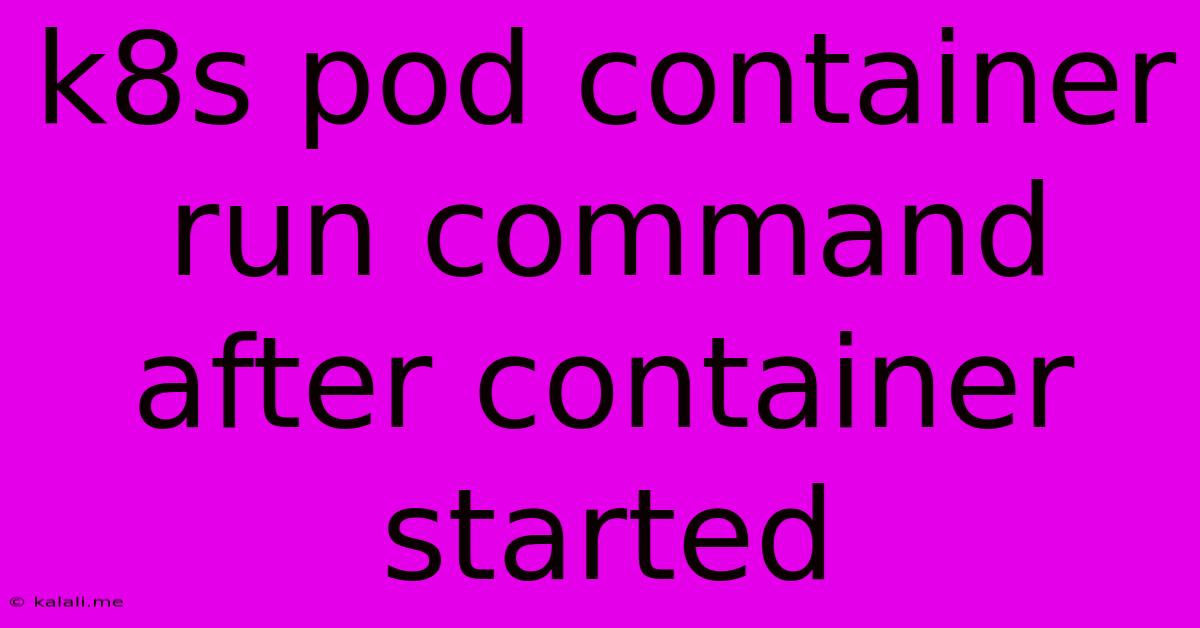K8s Pod Container Run Command After Container Started
Kalali
Jun 08, 2025 · 3 min read

Table of Contents
Running Commands in a Kubernetes Pod Container After Startup
This article explores various methods for executing commands within a Kubernetes pod's container after the container has successfully started. This is a common requirement for tasks like running initialization scripts, performing post-startup checks, or interacting with the running application. We'll cover several approaches, their pros and cons, and best practices. Understanding these techniques is crucial for effective Kubernetes deployment and management.
Why Run Commands After Container Startup?
Simply adding commands to your container's ENTRYPOINT or CMD instructions might not always suffice. Sometimes, you need actions to happen after the main application process has initialized. Examples include:
- Database migrations: Applying database schema changes after the database server has started.
- Health checks: Verifying application readiness before exposing it to traffic.
- Configuration updates: Fetching configuration data from a remote source post-startup.
- One-time initialization tasks: Running scripts to set up initial state or environment variables.
Let's delve into the practical methods to accomplish this.
Method 1: Using an Init Container
Init containers run before your main application containers. They're ideal for tasks that must complete before the application starts. This approach ensures the command executes reliably, as the main container won't launch until the init container succeeds.
Pros: Guaranteed execution before the main container, robust error handling. Cons: Adds complexity; requires defining an additional container in your pod specification.
Example:
apiVersion: v1
kind: Pod
metadata:
name: my-pod
spec:
initContainers:
- name: init-script
image: busybox
command: ["sh", "-c", "echo 'Initializing...' && sleep 5 && touch /initialized"]
containers:
- name: main-container
image: my-app
command: ["/bin/sh", "-c", "if [ -f /initialized ]; then echo 'Application started'; else echo 'Initialization failed!'; fi"]
This example uses busybox to simulate an initialization script. The main-container then checks for the initialized file, indicating successful completion.
Method 2: Sidecar Container & Inter-Process Communication
A sidecar container runs alongside your main application container. It can communicate with the main container using mechanisms like shared volumes, network sockets, or environment variables. This allows the sidecar to trigger commands in the main container (though indirectly).
Pros: Flexible, allows for complex interactions. Cons: Requires careful orchestration of communication between containers.
Method 3: Executing Commands Using kubectl exec
This is a post-deployment method; you use the kubectl exec command to execute commands inside a running container. This is useful for ad-hoc tasks or troubleshooting. However, it's not ideal for automated initialization.
Pros: Simple for one-off tasks. Cons: Manual intervention required, not suitable for automated post-startup actions.
Method 4: Using a Post-Start Hook (Less Reliable)
While some Kubernetes solutions offer post-start hooks, their reliability varies. These hooks aren't part of the core Kubernetes specification, and their behavior might differ across different Kubernetes distributions. They are not a recommended approach for critical initialization tasks.
Best Practices & Considerations
- Idempotency: Ensure your commands are idempotent (can be run multiple times without unintended side effects).
- Error Handling: Implement robust error handling to prevent failures from cascading.
- Resource Management: Be mindful of resource consumption, especially for init containers.
- Security: Follow security best practices when using containers and executing commands.
By carefully considering these methods and best practices, you can reliably execute commands in your Kubernetes pod containers after startup, ensuring robust and predictable application behavior. Remember to choose the method best suited to your specific needs and context. Init containers offer the most reliable approach for guaranteed execution before the main application starts.
Latest Posts
Latest Posts
-
How To Improve Your Vocal Range
Jun 08, 2025
-
Can Ps Vita Games Play On Psp
Jun 08, 2025
-
What Plugin Can Overload The Php Memory
Jun 08, 2025
-
What Special Abilities Does Athena Have Pokemon
Jun 08, 2025
-
Are Russian And Ukrainian Mutually Intelligible
Jun 08, 2025
Related Post
Thank you for visiting our website which covers about K8s Pod Container Run Command After Container Started . We hope the information provided has been useful to you. Feel free to contact us if you have any questions or need further assistance. See you next time and don't miss to bookmark.